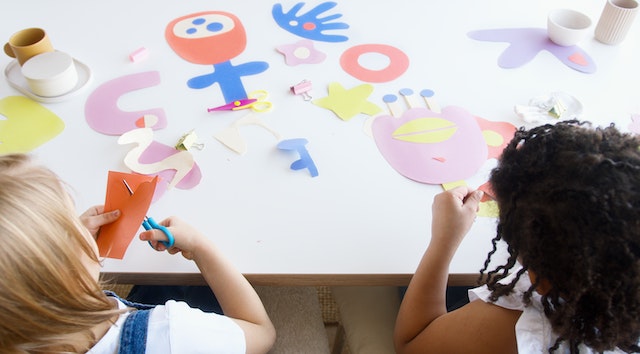Kids love experimenting and learning new things. Whether it is playing in the water, drawing scenery, rolling dough, or learning to use mobile phones, kids get excited about doing it all. This excitement is very healthy as it helps children’s minds grow and explore new things. But it also requires proper supervision.
As per research, children learn things faster than adults. The ability to imbibe new things decreases as age increases. This has both pros and cons. If taught correctly, children can learn new things very easily and in the right manner. In fact, if we go by the research, childhood is the best time to teach new things to kids. But slight negligence while teaching them can give kids the lifelong habit of doing something wrong.
In this article, we are going to discuss one such learning experience and how it can be properly guided. We will be talking about how to teach kids scissor skills with the proper guidance of the parents.
7 tips for teaching scissor skills to preschoolers
So let us understand how to approach teaching scissor skills to preschoolers.
1. Start with teaching children mind-body coordination
Before letting kids carry the scissors, teach them how to open and close things. This will help children coordinate their mental and physical actions, which is crucial to teaching scissor skills to preschoolers. Learning the way to hold the scissor is a very important part of scissor skills. It requires coordination of the mind, hand, eyes, and posterior. So before handing over scissors to kids, teach them techniques to hold, open and close things. Give them tongs, spray bottles, and clothes peg so that they learn how to open and close things properly and within time. This training will help kids in understanding the coordination of the body and mind while behind opening the scissors and closing them safely.
2. Teach children how to hold scissors
According to experts, the best age at which children must be taught to hold scissors starts from 1.5 to 2 years. Learning to hold scissors correctly is a very important skill as it also helps children enhance their pencil-holding skills and handwriting. For this, parents will have to teach them about the ‘thumbs up’ rule. This means they will have to help their kids hold scissors in a thumbs-up position. In other words, the thumb should be in one loop of the scissor and the index and the middle finger in another loop.
3. Use different types of scissors
The first and foremost thing before learning scissor skills is to choose the right scissor. At the initial stage, remember to use scissors without blades so that even if children make mistakes, they won’t get hurt. Slowly you can move to scissors with blunt ends and regular small scissors. Here are some scissors that you choose from for teaching scissor skills to preschoolers.





 4. Give them the opportunity to tear papers
4. Give them the opportunity to tear papers
Once your child is ready with the skills to hold the scissor safely, familiarize them with the idea of cutting. Every activity that a child learns should be backed by proper reasons to help them adapt to the skills comfortably. And as far as the idea of cutting is concerned, it is in itself an uncomfortable idea. So parents need to be careful before teaching them what it means to cut things. Tearing paper is a crucial step in pre-scissor skills. Allow your kids to tear paper into small pieces so that they familiarize themselves with the idea of cutting. Moreover, teach them that cutting is good only if it is asked or needed. Take special precautions so that kids don’t go on a spree of cutting anything that they have their hands on once they learn scissor skills.
5. Start snipping
After kids are familiar with holding the scissor properly, start teaching them to snip things. Teach children the purpose of both hands in scissor skills. Children must know to balance the use of the hand curled up the loops of the scissor and the hand that is used for holding the paper that is being cut. This coordination is important to avoid any cuts or hazards.
Some early learning experts believe children should start snipping by cutting play dough and straws. In contrast, others claim that children can start with paper cutting immediately. Be it anything, the point is that parents must guide children through the snipping process; Provide them with hand-over-hand assistance in the initial stage of cutting.
6. Start cutting shapes, and curved lines
As children start to learn cutting skills, encourage them to cut out shapes from papers or magazines. This practice needs a lot of attention as it requires the child to focus on the boundary lines of shapes. So help kids concentrate and focus on the shape and how they turn and twist the scissor.
Recommended reading: Top 50 Books For 3 To 5 Year Olds
Recommended reading: 35 Best Interactive Books For Toddlers
7. Teach snipping as per age
Snipping skills differ with the age of kids. A kid 2-year-old must snip only once at a time. A kid who is 3 years old must snip along a short line, while 4 and 5 years old kids can cut through long straight and curved lines, shapes, etc.
Teaching new things to kids must be carried out very carefully. Perhaps parents too can first learn the right way to do things and then teach children for an effective learning experience.
20 scissor activities for preschoolers
Engaging preschoolers in scissor activities is a great way to develop their fine motor skills, hand-eye coordination, and creativity. Working with scissors also helps them learn important skills like cutting along lines, controlling their movements, and following directions. Here are 20 fun and educational scissor activities for preschoolers:
1. Cut out shapes
Provide different colored papers and let children practice cutting out shapes like circles, squares, and triangles.
2. Paper chains
Show them how to cut strips of paper and connect them to create colorful paper chains.
3. Magazine collage
Give children old magazines and ask them to cut out pictures or words that interest them. Then, they can create collages on paper.
4. Snip the lines
Draw straight lines on a paper and ask children to cut along the lines.
5. Cutting playdough
Give preschoolers playdough and child-safe scissors. They can practice cutting the playdough into different shapes.
6. Cutting straws
Provide colorful straws and ask children to cut them into smaller pieces.
7. Cutting yarn
Give children yarn and ask them to cut it into different lengths.
8. Paper plate animals
Have children cut out different shapes from paper plates to create animals like lions, frogs, or butterflies.
9. Fruit and vegetable cutting
Provide soft fruits like bananas or cucumbers and child-safe knives for children to practice cutting.
10. Cutting patterns
Draw patterns on paper, such as wavy lines or zigzags, and have children cut along the lines.
11. Cutting out letters
Write letters of the alphabet on paper and ask children to cut them out.
12. Cutting shapes from playdough
Have children flatten playdough and use cookie cutters or plastic stencils to cut out different shapes.
13. Snipping straws
Show children how to snip the ends of plastic straws to create fringes.
14. Cutting out pictures for a collage
Provide old magazines or newspapers and ask children to cut out pictures that fit a particular theme, such as animals or food.
15. Cutting along curves
Draw curved lines on paper and encourage children to cut along the lines.
16. Cutting out paper dolls
Print or draw paper dolls, and let children cut them out and decorate them with crayons or markers.
17. Cutting and sorting shapes
Draw different shapes on different pieces of paper and ask children to cut them out and sort them into groups.
18. Cutting wrapping paper
Give children small pieces of wrapping paper and let them practice cutting it into different shapes or strips.
19. Cutting out pictures for a story
Read a story to the children and ask them to cut out pictures that represent different parts of the story. Then, they can use the pictures to retell the story.
20. Cutting out a paper snowflake
Show children how to fold a paper and create a snowflake by cutting out different shapes from it.
Recommended reading: 3 Essential Skills Needed Before Your Child Starts to Write
Remember to always supervise children during scissor activities and provide child-safe scissors appropriate for their age and skill level. Encourage them to take their time, be patient, and celebrate their achievements. Scissor activities not only help preschoolers develop essential skills but also promote creativity and self-expression.
Want to share your experience of teaching scissor skills to preschoolers? Share in comments. We would love to read!







